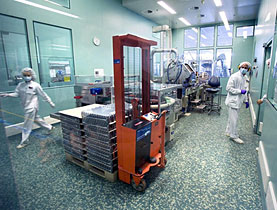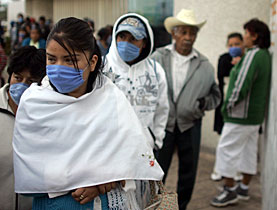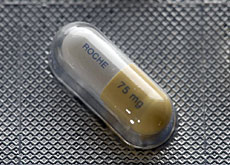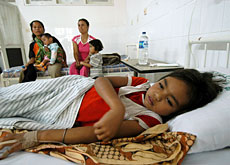Pandemic scare raises Tamiflu resistance fear

Anti-viral drug Tamiflu must be used with care to avoid the new strain of swine flu developing resistance, an expert on infectious diseases has warned.
The drug, developed by Swiss pharmaceutical firm Roche, would be one of the primary defences against a pandemic. Experts are closely watching the deadly flu outbreak that started in Mexico.
The new strain of influenza, H1N1, is already believed to have claimed more than 150 lives in Mexico, and cases have also been detected in the United States, Canada, Spain and Britain.
On Monday the Federal Health Office confirmed that five Swiss who had just returned from Mexico all had the symptoms of influenza and had visited their doctors as a precautionary measure.
The virus originally spread from pigs to humans, but unlike avian flu that struck in Asia, the latest strain can be transmitted between humans. This phenomenon makes it harder to contain the spread of the disease.
The World Health Organization (WHO) raised its global alert level to Phase 4 on Monday, stopping short of declaring a pandemic but signalling that the virus was becoming increasingly adept at spreading among humans
Pietro Vernazza, head of the infectious diseases department at St Gallen cantonal hospital, said Tamiflu and another drug called Relenza would be essential tools to combat a pandemic. The WHO and several countries have stockpiled both drugs.
“Tamiflu and Relenza are very important but we must use them carefully,” Vernazza told swissinfo.
“The fear is if we use it inappropriately then there is a higher chance of resistance developing very fast. If we manage to prevent the development of resistance, those drugs will be life saving.”
Previous warnings
Vernazza said the drug must not be used as a general prophylactic for the whole population, but should be administered within 12 hours of a patient showing flu symptoms. Leaving treatment too late would reduce its effectiveness and increase the chances of resistance.
This is not the first time that resistance fears have been raised about Tamiflu. In 2006 researchers at the Federal Institute of Technology in Zurich warned of the dangers were the drug to be used as a prophylactic.
And later that year, at the peak of the bird flu outbreak, Roche was forced to issue a denial that some viruses were already showing signs of resistance to Tamiflu.
The fears appear not to have diminished the value of the drug, with Roche shares rising 3.5 per cent on Monday with the expectation of further stockpiling.
Vernazza said bird flu was ten times deadlier than the new swine flu, which appears to have a mortality rate of around five per cent even among healthy young adults. But there is a greater chance of swine flu spreading around the world because it can be passed on between humans.
Another problem with swine flu is that it is hard to detect because the virus looks like normal flu strains. Added to that, people are most contagious the day before showing symptoms, making it nearly impossible to contain, according to Vernazza.
Close schools
The only way to slow the spread of contagion would be to stop people getting together, he said. “We would have to close schools, museums and theatres, anywhere where people gather to reduce the possibility of it spreading,” he told swissinfo.
“Mathematical models have shown that if you just limit then you can slow the spread of the disease dramatically.”
Vernazza compared the latest virus with the Spanish flu, which is thought to have killed some 50 million people in 1918. However, modern communications, health standards and medical advances would limit the damage until a vaccine could be developed, he added.
“It was a completely different era then when we were not aware of the situation, we could not detect the virus, it was just after the First World War and we did not have drugs to combat the infection,” he said.
swissinfo, Matthew Allen
Anti-viral drug Tamiflu is one of the first defences against the outbreak of an influenza pandemic. It was effective against bird flu and the WHO has cleared it for use against swine flu.
Roche ramped up production of the drug in 2005 at the outbreak of avian flu, but cut back in 2007 as governments and health organisations scaled back their stockpiling programmes.
The WHO currently has enough Tamiflu – or oseltamivir – to treat five million people, while various countries also hold stockpiles.
Roche could scale up its production to produce some 400 million treatments a year, but there would be an eight-month delay until the first course reached the market.
Roche also has agreements with drug makers in South Africa, China and India allowing them to produce Tamiflu. Roche has three million courses in its own warehouses and previously donated two million courses to WHO for use in under-developed countries.
Another drug that has been recognised as an effective treatment is Relenza, produced by British company GlaxoSmithKline.

In compliance with the JTI standards
More: SWI swissinfo.ch certified by the Journalism Trust Initiative




You can find an overview of ongoing debates with our journalists here. Please join us!
If you want to start a conversation about a topic raised in this article or want to report factual errors, email us at english@swissinfo.ch.